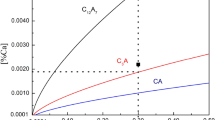Conclusions
-
1.
Deoxidation with silicon and also with mangnese and silicon leads to formation of inclusions of simple composition. In deoxidation with manganese, silicon, and aluminum in combination, inclusions of complex composition are formed.
-
2.
An increase in oxygen content leads to an increase in plastic properties of the metal, which is probably related to the decrease in the tendency toward austenitic grain growth.
-
3.
For deoxidation with silicon and also with silicon, manganese, and aluminum in combination, with which globular inclusions were obtained, increase in area of inclusions led to an increase in plastic properties since globular inclusions are not stress raisers. As opposed to this in deoxidation with aluminum and also with silicon and manganese in combination the increase in area of coarse inclusions reduces the plastic properties.
Similar content being viewed by others
Literature cited
V. I. Yavoiskii, Yu. V. Kryanovskii, et al., The Metallurgy of Steel [in Russian], Metallurgiya, Moscow (1983), pp. 266–267.
Stahl und Eisen,102, No. 22, 54 (1982).
Additional information
Bol'shevik Plant. Moscow Institute of Steel and Alloys. Translated from Metallovedenie i Termicheskaya Obrabotka Metallov, No. 9, pp. 13–16, Septerber, 1991.
Rights and permissions
About this article
Cite this article
Gutovskii, I.B., Bodnarchuk, V.I., Kochkin, V.G. et al. Influence of oxide inclusions on the mechanical properties of steel with a low carbon content. Met Sci Heat Treat 33, 667–671 (1991). https://doi.org/10.1007/BF00811728
Issue Date:
DOI: https://doi.org/10.1007/BF00811728




